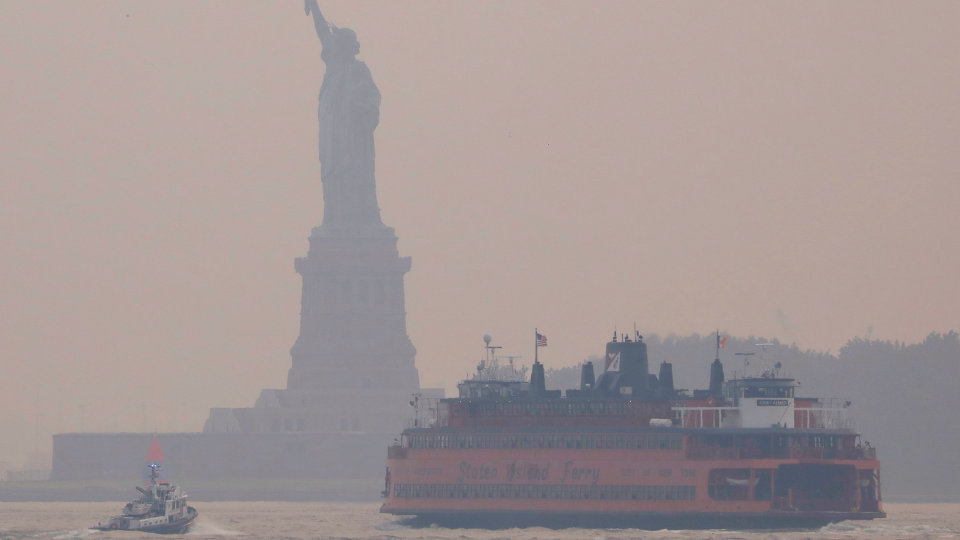Disclaimer: This article was written in late July, 2021. Information may have changed or seem out-of-date since it’s publication date of September 10.
On Wednesday, July 20, Hoboken residents woke up with a reddish smog blocking their New York City view. The Air Quality Index (AQI) measured 128, a far cry from “healthy,” which ranges from 0 to 50. This is not the first—and certainly not the last—time Hoboken will experience this severe drop in air quality. As West Coast wildfires persist relentlessly from Oregon down to Northern California, New York City and its urban sprawl will continue to experience their effects.
Wildfires are not uncommon on the West Coast; California has a fire season that starts in summer and extends into early fall. But this is the first time since 2014 that parts of California are under a “red flag” warning. The “red flag” warning stretches from Redding in the North and Modesto in the south. Parts of the state capital, Sacramento, and edges of the Bay area were included. The National Weather Service describes a red flag warning as significantly warmer temperatures than normal, stronger dry winds accompanied by an increased risk of fires. Residents in red flag warning zones are advised not to burn trash or other items in their areas. Throwing cigarettes or matches out of vehicles is not allowed as well as leaving any indoor fires unattended.
The Beckwourth Complex fire and Dixie Fire in Northern California measured 105,670 acres and 240,795 acres respectively. Both fires reignited trauma for residents that survived California’s deadliest wildfires in history. For context, the Dixie fire has burned an area larger than New York City over the course of two weeks. For many Californians, the red skies, dense smoke, and the sound of helicopters have become the new normal.
Parts of southern Oregon were also placed in a “red flag” warning, as extreme heat waves and dry conditions persisted. The U.S. Forest Service measured the Bootleg Fire in Fremont-Winema 413,562 acres. Residents of the nearby Klamath County were forced to evacuate their homes on the sixth day. Electrical lines from Oregon to California were interrupted as the result of both fires. People from California and Oregon “lost thousands of megawatts of power” while simultaneously trying to maintain operating reserves.
Much of the West Coast, specifically California, has had the driest spring on record in 40 years. These concerning conditions exacerbated the spread of the wildfires. The little waterfall and heatwaves accelerated the process of curing. Curing is defined as the process of vegetation drying out to the point where the moisture concentration is influenced by the dryness of the atmosphere, and no longer the soil. Meteorologist Gerry Diaz described that typically “we wouldn’t be dealing with this (curing) until the traditional fire season in fall.”
Meteorologists and scientists believe that the early start of the fire season is attributed to the long term effects of climate change. President Biden and Vice President Harris remarked on the recent wildfires, commenting that prevention efforts “like forest management” and “restoring millions of acres of high risk areas to protect homes and public water sources for drinking” are key to confronting climate change. But unfortunately, government officials cannot ignore that our atmosphere and ecosystems are intertwined. Factors of extreme heat and prolonged droughts are magnified due to the positive feedback loop of our overlapping ecosystems.
Mitigation of climate change throughout the years has become more difficult. Many states are trying to promote the adoption of clean energy resources. In fact, Governor Murphy signed a bill early in July to reach the goal of 100 percent clean energy by 2050. This bill is marked by smaller milestones such as creating programs to promote electric vehicle adoption and infrastructure.
Waking up and seeing the smog from the east coast is just one of the small effects of a much larger issue. Not only do the west coast wildfires expose the underlying concern of climate change, but rather the delay that governments are having in creating proactive solutions. Time will not stop to wait for governments to slowly implement the mitigation of climate change.

Be First to Comment